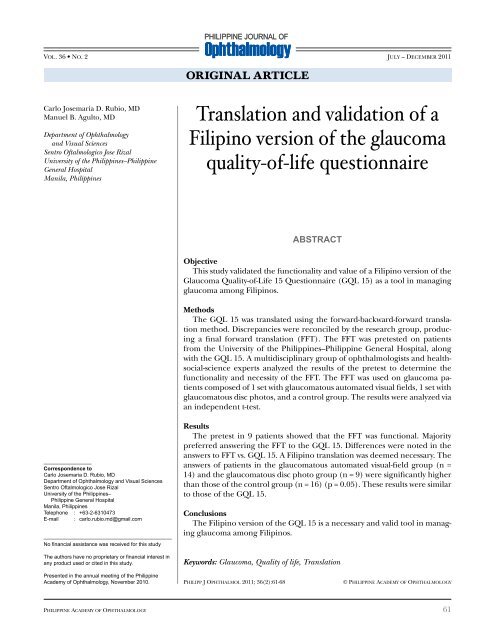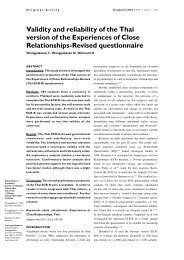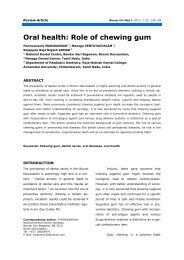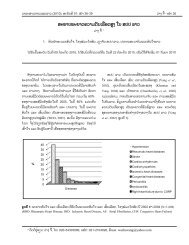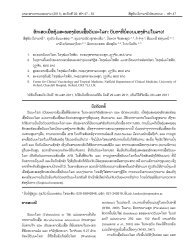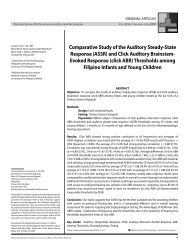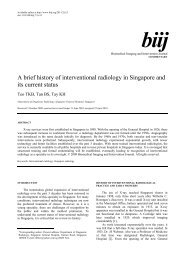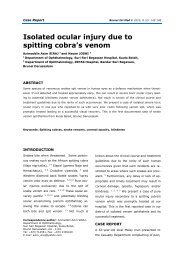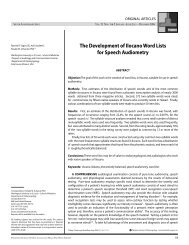Translation and validation of a Filipino version of the glaucoma ...
Translation and validation of a Filipino version of the glaucoma ...
Translation and validation of a Filipino version of the glaucoma ...
Create successful ePaper yourself
Turn your PDF publications into a flip-book with our unique Google optimized e-Paper software.
Glaucoma causes characteristic visual-field loss<strong>and</strong> optic neuropathy. If severe enough, it can lead tosignificant visual disability 1-2 <strong>and</strong> affect quality <strong>of</strong> life.A patient’s ability to enjoy normal life activities can becompromised. This can be assessed through specific validatedtools, such as <strong>the</strong> different health-related quality<strong>of</strong>-lifequestionnaires (HRQoL). The use <strong>of</strong> a HRQoLallows <strong>the</strong> patient’s perspective to be included in <strong>the</strong>methodological framework <strong>of</strong> evidence-based medicine.These questionnaires have shown usefulness in assessingvarious life-threatening, progressive, or chronic illnesses,such as <strong>glaucoma</strong>. 3Some <strong>of</strong> <strong>the</strong>se quality-<strong>of</strong>-life assessment tools havebeen used to assess <strong>the</strong> quality <strong>of</strong> life <strong>of</strong> <strong>glaucoma</strong> patients.Several <strong>of</strong> <strong>the</strong> questionnaires are not disease-statespecific, such as <strong>the</strong> Medical Outcomes Study Short Form36 (SF-36) <strong>and</strong> <strong>the</strong> Sickness Impact Pr<strong>of</strong>ile (SIP). SF 36is an easy-to-use questionnaire known as a multipurposemedical-health survey. Despite being considered reliable,it has not been shown to correlate well with vision-relatedailments, such as <strong>glaucoma</strong>. The SIP is considered a valid<strong>and</strong> reliable tool for assessing quality <strong>of</strong> life in diseasestates, but is deemed impractical in clinical setting dueto <strong>the</strong> length <strong>of</strong> time it takes to complete <strong>the</strong> questionnaire.4O<strong>the</strong>r questionnaires are vision specific, but not necessarilyspecific for <strong>glaucoma</strong>. Examples are <strong>the</strong> VisualFunction Index-14 (VF-14), <strong>the</strong> National Eye InstituteVisual Function Questionnaire (NEI-VFQ), <strong>and</strong> <strong>the</strong> NEI-VFQ 25. The VF-14 was originally developed to assessquality <strong>of</strong> life <strong>of</strong> cataract patients <strong>and</strong> has only moderaterelevance to assessing impact <strong>of</strong> visual acuity on quality<strong>of</strong> life among <strong>glaucoma</strong> patients. Since it failed to takeinto consideration <strong>the</strong> effects <strong>of</strong> visual field <strong>and</strong> colorvision defects, two important indicators <strong>of</strong> optic-nervedamage, it has proved inadequate in measuring quality<strong>of</strong> life in <strong>glaucoma</strong>. The NEI-VFQ, a well-validated tool inassessing vision-dependent tasks, is more sensitive than<strong>the</strong> SF-36 in differentiating patients with <strong>glaucoma</strong>, but isdifficult to use. The NEI-VFQ 25 is an improved <strong>version</strong><strong>of</strong> <strong>the</strong> NEI-VFQ. Despite being easy to use, well validated,<strong>and</strong> reliable, its lack <strong>of</strong> emphasis on visual-field effect onquality <strong>of</strong> life has lessened its test value in <strong>glaucoma</strong>. Inspite <strong>of</strong> its shortcomings, it is one <strong>of</strong> <strong>the</strong> more widely used(<strong>and</strong> translated) visual-field-function questionnaires.Along with <strong>the</strong> NEI-VFQ, it has become <strong>the</strong> benchmarkfor quality-<strong>of</strong>-life questionnaires specific to <strong>glaucoma</strong>. 4There have been various attempts in <strong>the</strong> past decadeto create a <strong>glaucoma</strong>-specific HRQoL. Roul<strong>and</strong> <strong>and</strong> colleagues<strong>of</strong> <strong>the</strong> Hôpital Claude Huriez in Lille, France,noted a lack <strong>of</strong> HRQoLs for ophthalmologists. Theycreated <strong>the</strong> first <strong>glaucoma</strong>-specific quality <strong>of</strong> life scaleto provide researchers <strong>and</strong> physicians a comprehensive,practical, <strong>and</strong> validated tool for assessing patients with<strong>glaucoma</strong>. 3The Glaucoma Quality-<strong>of</strong>-Life Questionnaire (GQL15) was designed by Nelson <strong>and</strong> colleagues in 2003. 5 Theyattempted “to explore patients self-reported visual disabilityresulting from <strong>glaucoma</strong> by means <strong>of</strong> a questionnairedeveloped for this purpose; identify activities stronglyassociated with a measure <strong>of</strong> visual-field loss; quantify differentpsychophysical aspects <strong>of</strong> visual function; <strong>and</strong> assess<strong>the</strong> relationship between objective measures <strong>of</strong> visualfunction <strong>and</strong> patients’ perception <strong>of</strong> <strong>the</strong>ir vision-relatedquality <strong>of</strong> life.” Of <strong>the</strong> 50 questions used in <strong>the</strong> study, 15were noted to have a strong <strong>and</strong> significant relationshipwith a measure <strong>of</strong> visual-field loss, which comprise now<strong>the</strong> GQL 15. The perceived visual disability relating todark adaptation, disability glare, activities dem<strong>and</strong>ingfunctional peripheral vision was highly associated with<strong>the</strong> severity <strong>of</strong> binocular visual-field loss. The GQL 15was developed to include 5 key activity groups in dailyliving, namely central <strong>and</strong> near vision, peripheral vision,dark adaptation <strong>and</strong> glare, personal care, <strong>and</strong> outdoormobility.The GQL 15 has been used in various studies. Goldberg<strong>and</strong> associates used <strong>the</strong> GQL 15 to quantify difficulty in<strong>the</strong> performance <strong>of</strong> daily activities in patients with openangle<strong>glaucoma</strong> (OAG). They demonstrated that patientswith OAG had a significant deterioration in quality <strong>of</strong>life which correlated strongly with reduced visual acuity,severity <strong>of</strong> visual-field defects, <strong>and</strong> presence <strong>of</strong> binocularfield defects. 6Country-specific quality-<strong>of</strong>-life questionnaires werealso developed. Toit <strong>and</strong> colleagues developed <strong>and</strong> validateda vision-specific quality-<strong>of</strong>-life questionnaire <strong>of</strong> EastTimorese. 7 Krochik et al. translated <strong>the</strong> National EyeInstitute Visual Function Questionnaires into Spanish inBuenos Aires, Argentina. 8Currently, <strong>the</strong>re is no validated <strong>Filipino</strong> <strong>glaucoma</strong>quality <strong>of</strong> life questionnaire. This study aimed to develop<strong>and</strong> validate a vision- <strong>and</strong> language- or vernacular-specificGQL–15 adapted to <strong>Filipino</strong> <strong>glaucoma</strong> patients, whichcould reveal peculiar self-proclaimed insights into <strong>the</strong>debilitating effects <strong>of</strong> <strong>glaucoma</strong> on vision <strong>and</strong> life itself.We translated <strong>the</strong> Glaucoma Quality <strong>of</strong> Life Questionnaire15 (GQL–15) into <strong>Filipino</strong>, determined its value,<strong>and</strong> validated its usefulness among patients.METHODOLOGYAfter assessment <strong>of</strong> <strong>the</strong> different vision-specific quality<strong>of</strong>-lifequestionnaires, <strong>the</strong> Glaucoma Quality <strong>of</strong> Life Questionnaire–15(GQL–15) was used as basis for <strong>the</strong> <strong>Filipino</strong>questionnaire.The translation procedure involved translation, reconciliation,pretesting, <strong>and</strong> small-group discussion based62 Philipp J Ophthalmol Vol. 36 No. 2 July – December 2011Philippine Academy <strong>of</strong> Ophthalmology
on <strong>the</strong> Kidscreen group <strong>Translation</strong> <strong>and</strong> Validation procedure.9 Modifications to <strong>the</strong> translation <strong>and</strong> <strong>validation</strong>procedure were suggested <strong>and</strong> approved by an expert.The GQL–15 was translated into a <strong>Filipino</strong> <strong>version</strong> using<strong>the</strong> forward-backward-forward method. The questionnairewas first translated into <strong>Filipino</strong> by one independenttranslator (forward translation) who was a native speaker<strong>Filipino</strong> speaker, pr<strong>of</strong>icient in both English <strong>and</strong> <strong>Filipino</strong>,<strong>and</strong> familiar with <strong>the</strong> cultures <strong>of</strong> both <strong>the</strong> English-speakingcountries <strong>and</strong> <strong>the</strong> Philippines. The forward translation wastranslated back into English by a second translator, whohad not worked with <strong>the</strong> original GQL–15.Members <strong>of</strong> <strong>the</strong> research group with good knowledge <strong>of</strong>English <strong>and</strong> <strong>Filipino</strong>, as well as <strong>the</strong> forward translators, compared<strong>the</strong> backward translation with <strong>the</strong> original GQL–15.The group compared <strong>the</strong> backward translation with <strong>the</strong>original GQL–15 item by item, eventually suggesting a <strong>version</strong>for <strong>the</strong> final forward translation. The back-translated<strong>and</strong> original questionnaire should have been very similar.The discrepancies between <strong>the</strong> two questionnaires wereidentified <strong>and</strong> resolved. The reconciliation process wasconfirmed for certain translations <strong>and</strong> an alternativesuggestion was given to o<strong>the</strong>r translations which were notconfirmed. The end product was <strong>the</strong> final forward translation,which was expected to not have any conceptualdiscrepancies with <strong>the</strong> English original. The entire process<strong>of</strong> translation was documented appropriately.Additional questions specific for <strong>the</strong> <strong>Filipino</strong> way <strong>of</strong> lifewere generated as necessary by interviews with diagnosed<strong>glaucoma</strong> patients, additional literature review, <strong>and</strong> consultationwith experts in <strong>the</strong> field <strong>of</strong> <strong>glaucoma</strong>.Patients from <strong>the</strong> Sentro Oftalmoligico Jose Rizal <strong>of</strong> <strong>the</strong>University <strong>of</strong> <strong>the</strong> Philippines–Philippine General Hospital(UP–PGH), diagnosed to have <strong>glaucoma</strong>, made up <strong>the</strong>study population. Included were patients who:• had been diagnosed with primary <strong>glaucoma</strong>, whe<strong>the</strong>ropen-angle or angle-closure, <strong>and</strong> had been seen by at leastone consultant;• were more than 20 years old <strong>and</strong> can read, write, <strong>and</strong>speak in conversational <strong>Filipino</strong>;• had best-corrected distance visual acuity <strong>of</strong> 20/40 orbetter;• had undergone at least 2 automated visual-field testssince <strong>the</strong> time <strong>of</strong> diagnosis (<strong>the</strong> perimetry tests shouldbe reliable, with less than three fixation losses <strong>and</strong> bothfalse-negative <strong>and</strong> false-positive responses less than 10%each <strong>and</strong> <strong>the</strong> tests should have been <strong>of</strong>ficially read by aconsultant);• were deemed to be neurologically capable <strong>of</strong> answering<strong>the</strong> questionnaire (i.e. those oriented to time/place/person, those with intact sensorium);• who have had at least one photo <strong>of</strong> <strong>the</strong> optic nerves<strong>of</strong>ficially read by a consultant;• may or may not have undergone <strong>glaucoma</strong>-relatedsurgery (filter, valve, or laser surgery) or cataract surgery;<strong>and</strong>• had been regularly consulting (at least 4 follow-ups)at <strong>the</strong> UP–PGH Glaucoma Clinic within <strong>the</strong> past calendaryear.Excluded were patients who:• had eye diseases o<strong>the</strong>r than <strong>glaucoma</strong> (retinal pathologies,non-<strong>glaucoma</strong>tous optic-nerve pathologies) or<strong>glaucoma</strong> secondary to an underlying eye disease;• had undergone eye surgery not directly related to <strong>the</strong>primary <strong>glaucoma</strong>tous pathology (i.e. retina surgery, penetratingkeratoplasty, panretinal photocoagulation, etc.);• were unable to read, write <strong>and</strong> converse in conversational<strong>Filipino</strong>.A control group <strong>of</strong> patients with no known eye diseaseaffecting vision to below 20/40 for distance vision with appropriatecorrection (i.e. correctible error <strong>of</strong> refraction)was recruited from <strong>the</strong> general clinic.Patients were asked to fill up a consent form indicating<strong>the</strong>ir willingness to participate in <strong>the</strong> study. The patients’name, age, sex, educational attainment <strong>and</strong> diagnosis werenoted.PretestingThe translated questionnaire was pretested vis-à-vis<strong>the</strong> original questionnaire to determine its functionality(whe<strong>the</strong>r it was too hard to underst<strong>and</strong>, confusing,inadequate, or <strong>the</strong>re were o<strong>the</strong>r issues <strong>the</strong> intervieweeswanted addressed) <strong>and</strong> whe<strong>the</strong>r or not <strong>the</strong>re is a need fora <strong>Filipino</strong> <strong>version</strong> <strong>of</strong> <strong>the</strong> <strong>glaucoma</strong> quality-<strong>of</strong>-life questionnairein <strong>the</strong> first place. The questionnaire was intervieweradministered.The patients were asked to score <strong>the</strong>mselveson a scale <strong>of</strong> 1 to 10 regarding <strong>the</strong>ir self-assessed pr<strong>of</strong>iciencyin English <strong>and</strong> <strong>Filipino</strong>. They were interviewed with bothquestionnaires (English <strong>and</strong> <strong>Filipino</strong>). The selection <strong>of</strong><strong>the</strong> first questionnaire to be used was done r<strong>and</strong>omly (flip<strong>of</strong> a coin). After <strong>the</strong> scores were taken, <strong>the</strong> patients wereasked regarding <strong>the</strong>ir comments on both questionnaires<strong>and</strong> whe<strong>the</strong>r <strong>the</strong>y understood better <strong>and</strong> preferred <strong>the</strong>questionnaire in <strong>Filipino</strong> or English.Small-group discussionThe pretesting results were discussed by <strong>the</strong> researchersalong with ano<strong>the</strong>r individual familiar with <strong>the</strong> use<strong>of</strong> screening tools in <strong>the</strong> health social sciences in asmall-group discussion (SGD) to determine whe<strong>the</strong>r <strong>the</strong>translated questionnaire could be adequately understood<strong>and</strong> answered by <strong>the</strong> patients (based on <strong>the</strong>ir commentsgiven during <strong>the</strong> pretesting phase). The SGD also tookinto consideration <strong>the</strong> comments <strong>of</strong> <strong>the</strong> patients regarding<strong>the</strong> content <strong>of</strong> <strong>the</strong> questionnaire. Specific items in<strong>the</strong> questionnaire were modified or altoge<strong>the</strong>r removedPhilippine Academy <strong>of</strong> Ophthalmology Philipp J Ophthalmol Vol. 36 No. 2 July – December 201163
depending on <strong>the</strong> patients’ comments <strong>and</strong> <strong>the</strong> SGD analysis.The SGD also determined whe<strong>the</strong>r or not a <strong>Filipino</strong>questionnaire was necessary based on <strong>the</strong> difference <strong>of</strong><strong>the</strong> patient’s scores (or lack <strong>the</strong>re<strong>of</strong>) in <strong>the</strong> English vs.<strong>the</strong> <strong>Filipino</strong> questionnaire <strong>and</strong> on <strong>the</strong> underst<strong>and</strong>ing <strong>and</strong>preferences <strong>of</strong> <strong>the</strong> patients. The SGD came up with <strong>the</strong>final <strong>Filipino</strong> Glaucoma Quality <strong>of</strong> Life Questionnaire.Validation <strong>of</strong> questionnaire as a <strong>glaucoma</strong>-screening toolTime-based sampling was used to select <strong>the</strong> patients tobe screened during <strong>the</strong> testing period (patients who qualifiedfor ei<strong>the</strong>r group, whe<strong>the</strong>r <strong>the</strong> <strong>glaucoma</strong> group or <strong>the</strong>control group, who came in during a one-week periodat <strong>the</strong> clinics.) The patients underwent a comprehensiveinterview <strong>and</strong> ophthalmologic examination. A researcherassociate administered <strong>the</strong> questionnaire to <strong>the</strong> patientsthrough an interview. Any comments from <strong>the</strong> patientsregarding <strong>the</strong> questionnaires <strong>and</strong> mode <strong>of</strong> administrationwere noted.The <strong>glaucoma</strong> patients were divided into two subgroups:those with primarily visual field defects (<strong>glaucoma</strong>tous-visual-fieldgroup or GVF) <strong>and</strong> those with large <strong>glaucoma</strong>tousdisc-photoor GDF. The mean scores <strong>of</strong> each subgroupwere computed <strong>and</strong> compared with those <strong>of</strong> <strong>the</strong> normalgroup using independent t-test. The level <strong>of</strong> significancewas set at p = 0.05.RESULTSSelection <strong>of</strong> questionnaireThe SF–36, NEI VFQ–25, <strong>and</strong> <strong>the</strong> GQL–15 wereconsidered for use in <strong>the</strong> study. Studies assessing <strong>the</strong>different quality-<strong>of</strong>-life questionnaires showed that <strong>the</strong>GQL–15 has good correlation with <strong>the</strong> clinical indices <strong>of</strong><strong>glaucoma</strong>. 3-6 It was, <strong>the</strong>refore, selected for translation.<strong>Translation</strong> procedureThe research group discussed <strong>the</strong> results <strong>of</strong> <strong>the</strong>translation process, paying attention to <strong>the</strong> similarity ordissimilarity <strong>of</strong> <strong>the</strong> forward translation to <strong>the</strong> originalGQL–15. The main discrepancy between <strong>the</strong> two involved<strong>the</strong> grading <strong>of</strong> <strong>the</strong> severity <strong>of</strong> difficulty.The original choices in <strong>the</strong>GQL 150 – do not perform for nonvisualreasonsThe forward translation’s choices0 – does not involve vision toperform task.1 – none 1 – no difficulty2 – a little bit 2 – some degree <strong>of</strong> difficulty3 – some 3 – frequently experiencing difficulty4 – quite a lot 4 – difficult to perform task due toblurred vision5 – severe 5 – cannot perform task due to novisionThe first two (1 <strong>and</strong> 2) were similar to <strong>the</strong> original <strong>version</strong>sbut not <strong>the</strong> last four. The discrepancy was traced to<strong>the</strong> forward translation. The back translation was similarto <strong>the</strong> forward translation in terms <strong>of</strong> <strong>the</strong> different possibleanswers regarding severity <strong>of</strong> difficulty. However, itwas <strong>the</strong> forward translation that was noted to be significantlydissimilar to <strong>the</strong> original, with <strong>the</strong> item “3 – some”being translated into “3 – madalas,” “4 – quite a lot” beingtranslated into “4 – hirap nang makakita,” <strong>and</strong> “5 – severe”being translated into “5 – wala nang makita.” It was agreedupon by <strong>the</strong> research group that <strong>the</strong> forward translationneeded to be rectified, with <strong>the</strong> final forward translation<strong>of</strong> <strong>the</strong> different answers for severity being “1 – kung angsagot ay hindi, 2 – kung medyo nahihirapan nang kaunti,3 – kung medyo madalas mahirapan, 4 – kung may malakinghirap, <strong>and</strong> 5 – kung may matinding hirap.” The vernaculartranslation was made more faithful with regard to quantification.Most <strong>of</strong> <strong>the</strong> 15 items that represented daily activitieswere deemed to have been adequately translated. Item 2,originally “walking after dark” was eventually back-translatedinto “walking in dark alleys.” The forward translationwas similar to <strong>the</strong> original text, <strong>and</strong> it was agreed uponthat <strong>the</strong> problem was with <strong>the</strong> forward translation <strong>and</strong>not <strong>the</strong> backward translation. Item 3, originally “seeing atnight” was eventually translated into “finding objects in<strong>the</strong> dark.” The backward translation was deemed responsiblefor <strong>the</strong> discrepancy, having translated <strong>the</strong> originalitem into “pagtingin-tingin o paghahanap ng bagay sa dilim.”This item was agreed upon to be translated to <strong>Filipino</strong>as “pagkita sa gabi,” in <strong>the</strong> final forward translation. Item9, originally “seeing objects coming from <strong>the</strong> side” wastranslated in <strong>the</strong> back translation into “looking at objectsaround you.” The forward translation was deemed to beadequate. The discrepancy was agreed upon to be in <strong>the</strong>back translation <strong>and</strong> thus <strong>the</strong> original forward translation“nakikita ang bagay sa paligid” was maintained. Item 13,originally “judging distance <strong>of</strong> foot to step/curb” waseventually translated into “depth perception in stepping”in <strong>the</strong> back translation. The forward translation,“pagtantya ng distansya ng paa papunta sa bangketa” wasdeemed to be adequate, <strong>and</strong> <strong>the</strong> problem was with <strong>the</strong>backward translation <strong>and</strong> so <strong>the</strong> original forward translationwas maintained.A final forward translation was agreed upon. The differenttranslations are in <strong>the</strong> appendix.PretestingThe final forward translation was used in a pretest: 5<strong>glaucoma</strong> <strong>and</strong> 4 normal patients were interviewed. Thepatients with <strong>glaucoma</strong> had educational attainmentranging from grade school to college undergraduate.The patients’ self-rating on English pr<strong>of</strong>iciency averaged64 Philipp J Ophthalmol Vol. 36 No. 2 July – December 2011Philippine Academy <strong>of</strong> Ophthalmology
4.6, with <strong>the</strong> lowest score 2, <strong>and</strong> <strong>the</strong> highest score 8. Thepatients’ self-rating on <strong>Filipino</strong> pr<strong>of</strong>iciency averaged9, with <strong>the</strong> lowest score 7 <strong>and</strong> <strong>the</strong> highest score 10 (3patients). There was a difference in <strong>the</strong> average scores <strong>of</strong><strong>the</strong> English <strong>and</strong> <strong>Filipino</strong> questionnaires <strong>of</strong> 4.4, <strong>the</strong> lowest2 <strong>and</strong> <strong>the</strong> highest 8. The absolute value <strong>of</strong> <strong>the</strong> difference<strong>of</strong> <strong>the</strong> scores per item was also totaled, with an average<strong>of</strong> 15. The biggest absolute value difference between <strong>the</strong>two scores was 31. There were also scores with small differences<strong>of</strong> between 2 <strong>and</strong> 9.The control population had educational attainmentranging from grade school to high school. They had anaverage rating for English pr<strong>of</strong>iciency <strong>of</strong> 6.25 with <strong>the</strong>highest score 8 <strong>and</strong> <strong>the</strong> lowest 5. They had an average<strong>Filipino</strong> pr<strong>of</strong>iciency <strong>of</strong> 9, with <strong>the</strong> lowest 8 <strong>and</strong> <strong>the</strong> highest10. The average difference in scores was 7.25. The averagedifference in <strong>the</strong> absolute values <strong>of</strong> <strong>the</strong> differences inscores per item was 7.75.All in all, 6 out <strong>of</strong> 9 patients had a self-pr<strong>of</strong>iciencyrating in English at least 5 points lower than in <strong>Filipino</strong>.Three <strong>of</strong> <strong>the</strong>se patients were responsible for <strong>the</strong> scoresthat had a large difference in <strong>the</strong> sum <strong>of</strong> absolute values<strong>of</strong> differences in scores per item. The average self-ratingwas 5.3/10 in English pr<strong>of</strong>iciency <strong>and</strong> 9/10 <strong>Filipino</strong>pr<strong>of</strong>iciency. Seven out <strong>of</strong> /9 commented that <strong>the</strong>y found<strong>the</strong> <strong>Filipino</strong> questionnaire easier to underst<strong>and</strong> <strong>and</strong>answer compared to <strong>the</strong> English questionnaire, with <strong>the</strong>rest commenting <strong>the</strong> opposite. None <strong>of</strong> <strong>the</strong> respondentsfound <strong>the</strong> need for additional questions.Small-group discussionThe results <strong>of</strong> <strong>the</strong> pretest were discussed by <strong>the</strong> researchgroup along with an expert. It was deemed that althoughnot all participants had a large difference in <strong>the</strong> scoresobtained from using <strong>the</strong> English vs. <strong>the</strong> <strong>Filipino</strong> questionnaire,<strong>the</strong> presence <strong>of</strong> individuals with large differences<strong>of</strong> answers <strong>of</strong> <strong>the</strong> English vs. <strong>the</strong> <strong>Filipino</strong> questionnairewas enough reason to have a <strong>Filipino</strong> questionnaire. Thiswas validated by <strong>the</strong> preference <strong>of</strong> all but 2 patients toanswer <strong>the</strong> <strong>Filipino</strong> questionnaire. Based on <strong>the</strong> results <strong>of</strong><strong>the</strong> pretest, none <strong>of</strong> <strong>the</strong> items in <strong>the</strong> translated questionnairewere modified <strong>and</strong> no items were added. It was aagreed upon that <strong>the</strong>re was enough reason warrant <strong>the</strong>need for <strong>the</strong> use <strong>of</strong> a <strong>Filipino</strong> <strong>version</strong> <strong>of</strong> <strong>the</strong> GQL–15, <strong>and</strong>that <strong>the</strong> final forward translation <strong>of</strong> <strong>the</strong> questionnairecould be used as is.ValidationThe final forward translation was administered topatients fulfilling <strong>the</strong> inclusion criteria. Time-basedsampling (1 week or 5 clinic days) was used. A total <strong>of</strong>13 patients with <strong>glaucoma</strong>tous-visual-field findings <strong>and</strong> 8patients with <strong>glaucoma</strong>tous-disc-photo findings qualifiedfor <strong>the</strong> study. The scores <strong>of</strong> patients with <strong>glaucoma</strong>tousvisual fields ranged from 16 to 64, with an average <strong>of</strong>34.15/75. The scores <strong>of</strong> patients with <strong>glaucoma</strong>tous-discphot<strong>of</strong>indings ranged from 23 to 62, with an average <strong>of</strong>34.5/75 (Table 1). The final forward translation was alsoadministered to normal population composed <strong>of</strong> 16 patients.Their scores ranged from 15 to 21, with an averagescore <strong>of</strong> 16.81 (Table 1).The average score <strong>of</strong> <strong>the</strong> group with <strong>glaucoma</strong>tousvisual-fieldfindings was compared to <strong>the</strong> average score<strong>of</strong> <strong>the</strong> control group using an independent t-test. Thenull hypo<strong>the</strong>ses were <strong>the</strong>re was no significant differencebetween <strong>the</strong> groups with <strong>glaucoma</strong> <strong>and</strong> <strong>the</strong> normal/control group. The computed t-value <strong>of</strong> <strong>the</strong> group with<strong>glaucoma</strong>tous visual fields was 2.66. The computed t-value<strong>of</strong> <strong>the</strong> group with <strong>glaucoma</strong>tous disc photos was 2.54.With a p value <strong>of</strong> 0.05, it was noted that <strong>the</strong> t values <strong>of</strong> <strong>the</strong><strong>glaucoma</strong>tous visual field group <strong>and</strong> <strong>the</strong> <strong>glaucoma</strong>tousoptic disc group were higher than <strong>the</strong> t-values for <strong>the</strong>irrespective degrees <strong>of</strong> freedom based on sample size. Bothnull hypo<strong>the</strong>ses were rejected <strong>and</strong> <strong>the</strong> alternative hypo<strong>the</strong>seswere accepted. There was a significant differencebetween <strong>the</strong> group with <strong>glaucoma</strong>tous visual fields <strong>and</strong><strong>the</strong> normal/control group. There was also a significantdifference between <strong>the</strong> group with <strong>glaucoma</strong>tous discphotos <strong>and</strong> <strong>the</strong> normal/control group.DISCUSSIONThe GQL–15 was chosen since it was shown to havegood correlation with clinical indices <strong>of</strong> <strong>glaucoma</strong>. Itshould be noted that <strong>the</strong> GQL–15 is just a vision-relatedquality-<strong>of</strong>-life questionnaire. The o<strong>the</strong>r vision-relatedquality-<strong>of</strong>-life questionnaires were not disease-specific.The GQL–15 includes questions on central <strong>and</strong> nearvision (questions 1, 14 <strong>and</strong> 15), peripheral vision (questions8, 9, 11, 12), dark adaptation <strong>and</strong> glare (questions2, 3, 5, 6 <strong>and</strong> 7), personal care (14) <strong>and</strong> outdoor mobility(questions 4, 10 <strong>and</strong> 13).The translation procedure was straightforward, with<strong>the</strong> two translators producing <strong>the</strong> required output. Itwas noted during evaluation <strong>of</strong> <strong>the</strong> translations that <strong>the</strong>most difficult part for both translators was translating <strong>the</strong>scale <strong>of</strong> <strong>the</strong> answers to <strong>the</strong> questionnaire, as described in<strong>the</strong> results. The research group carefully reconciled <strong>the</strong>differences between <strong>the</strong> two translations <strong>and</strong> compared<strong>the</strong>m to <strong>the</strong> original questionnaire to produce <strong>the</strong> finaltranslation. The difficulty in translation was attributed to<strong>the</strong> lack <strong>of</strong> a definite translation in <strong>Filipino</strong> <strong>of</strong> <strong>the</strong> Englishscale used in <strong>the</strong> original GQL–15 Questionnaire. Therest <strong>of</strong> <strong>the</strong> discrepancies as discussed in <strong>the</strong> results wereagreed upon to be minor differences, with <strong>the</strong> discrepanciesrectified in <strong>the</strong> final forward translation.The results <strong>of</strong> <strong>the</strong> pretest convinced <strong>the</strong> membersPhilippine Academy <strong>of</strong> Ophthalmology Philipp J Ophthalmol Vol. 36 No. 2 July – December 201165
Table 1.Validation ScoresGlaucoma AVFGroup28162635623527253047266423Glaucoma discphoto group2328264730253562Normal group21181718151515151515161722191516<strong>of</strong> <strong>the</strong> small group discussion that a <strong>Filipino</strong> <strong>version</strong> <strong>of</strong><strong>the</strong> GQL–15 Questionnaire was needed. Out <strong>of</strong> <strong>the</strong> 9pretested individuals, 7 remarked that <strong>the</strong>y had an easiertime answering <strong>the</strong> <strong>Filipino</strong> <strong>version</strong> <strong>of</strong> <strong>the</strong> questionnaire.The average <strong>of</strong> <strong>the</strong> self-rating in English pr<strong>of</strong>iciency <strong>of</strong><strong>the</strong> pretested patients was 5.33/10 as against 9/10 in<strong>Filipino</strong> pr<strong>of</strong>iciency, which <strong>the</strong> researchers deemed to bea significant difference. Six out <strong>of</strong> <strong>the</strong> 9 pretested individualshad a self-rating in English pr<strong>of</strong>iciency 5 points(out <strong>of</strong> 10) lower than in <strong>Filipino</strong> pr<strong>of</strong>iciency, which <strong>the</strong>group also found to be significant.What was even more significant were <strong>the</strong> 3 patientswhose sum <strong>of</strong> <strong>the</strong> absolute value <strong>of</strong> <strong>the</strong> differences <strong>of</strong>scores answered for each question in <strong>Filipino</strong> <strong>and</strong> Englishwere 23, 29 <strong>and</strong> 31, representing a large differencein <strong>the</strong> answers given when <strong>the</strong> patients were asked <strong>the</strong>same question in English <strong>and</strong> in <strong>Filipino</strong>. These patientshad self-rating in English pr<strong>of</strong>iciency at least 5 pointsout <strong>of</strong> 10 lower than in <strong>Filipino</strong> pr<strong>of</strong>iciency. These samepatients were also part <strong>of</strong> <strong>the</strong> group which remarked that<strong>the</strong>y had an easier time <strong>and</strong> preferred answering <strong>the</strong><strong>Filipino</strong> questions.Subjectively, it was noted during <strong>the</strong> interview that<strong>the</strong>se same patients had a difficult time underst<strong>and</strong>ing<strong>the</strong> English questions, but had an easier time answering<strong>the</strong> <strong>Filipino</strong> questions. Given all <strong>the</strong>se data, <strong>the</strong> group assessedthat <strong>the</strong>se patients had a difficult time underst<strong>and</strong>ing<strong>and</strong> answering <strong>the</strong> English questionnaire. Majority <strong>of</strong><strong>the</strong> respondents also preferred answering <strong>the</strong> <strong>Filipino</strong>questionnaire. All <strong>the</strong>se data <strong>and</strong> observations showedthat <strong>the</strong> <strong>the</strong>re was enough reason to produce a <strong>Filipino</strong><strong>version</strong> <strong>of</strong> <strong>the</strong> GQL–15.The <strong>validation</strong> showed that <strong>the</strong> scores <strong>of</strong> <strong>the</strong> groupswith <strong>glaucoma</strong> were around double that <strong>of</strong> <strong>the</strong> normalpopulation. Based on <strong>the</strong> independent t-test, <strong>the</strong>re wasa statistically significant difference between <strong>the</strong> scores <strong>of</strong><strong>the</strong> <strong>glaucoma</strong> patients <strong>and</strong> <strong>the</strong> normal population, using<strong>the</strong> final forward translation <strong>of</strong> <strong>the</strong> GQL–15 (p = 0.05).Since, like <strong>the</strong> English <strong>version</strong> <strong>of</strong> <strong>the</strong> questionnaire, <strong>the</strong><strong>Filipino</strong> <strong>version</strong> was able to have significantly differentscores between <strong>the</strong> two groups, <strong>the</strong> research groupdetermined that <strong>the</strong> final forward translation was a valid<strong>version</strong> <strong>of</strong> <strong>the</strong> GQL–15.In summary, <strong>the</strong> GQL–15 was successfully translatedinto <strong>Filipino</strong>.The English <strong>version</strong> <strong>of</strong> <strong>the</strong> GQL–15 will not sufficefor measuring quality <strong>of</strong> life in most <strong>Filipino</strong> patients.<strong>Filipino</strong> <strong>version</strong> <strong>of</strong> <strong>the</strong> GQL–15 is necessary to meaningfullymonitor <strong>Filipino</strong> patients with <strong>glaucoma</strong>, <strong>and</strong> seemssuperior to <strong>the</strong> English <strong>version</strong> in doing so.The final forward translation <strong>of</strong> <strong>the</strong> <strong>Filipino</strong> GlaucomaQuality <strong>of</strong> Life Questionnaire is a valid tool in assessingquality <strong>of</strong> life in patients with <strong>glaucoma</strong>.A larger population may be used in both <strong>the</strong> normal<strong>and</strong> <strong>glaucoma</strong> groups to more strongly validate <strong>the</strong><strong>Filipino</strong> <strong>version</strong> <strong>of</strong> <strong>the</strong> questionnaire as a valid tool inassessing quality <strong>of</strong> life among <strong>glaucoma</strong> patients. Thequestionnaire may be used to determine whe<strong>the</strong>r <strong>the</strong>reis increasingly poorer quality <strong>of</strong> life in patients withincreasingly more severe <strong>glaucoma</strong>, with regard to bothstructure <strong>and</strong> function.References1. South East Asia Glaucoma Interest Group Asia Pacific Guidelines, SecondEdition2. American Academy <strong>of</strong> Ophthalmology Basic <strong>and</strong> Clinical Science Course,Glaucoma, 2004-2005.3. Roul<strong>and</strong> JF, Denis P, Béchetoille A, et al. Du Groupe D’étude Glaucome Et QualitéDe Vie. Creating a specific quality-<strong>of</strong>-life questionnaire in patients with <strong>glaucoma</strong>:item generation. J Fr Ophthalmol 2002; 25: 785-794.4. Severn P, Fraser S, Finch T, May C. Which quality-<strong>of</strong>-life score is best for <strong>glaucoma</strong>patients <strong>and</strong> why? BMC Ophthalmology 2008 Jan 23: http://www.biomedcentral.com/1471-2415/8/2 (accessed October 21, 2009).5. Nelson P, Aspinal P, Papasouliotis O, et al. Quality <strong>of</strong> life in <strong>glaucoma</strong> <strong>and</strong> itsrelationship with visual function. J Glaucoma 2003; 12: 139-150.6. Goldberg I, Clement CI, Chiang TH, et al. Assessing quality <strong>of</strong> life in <strong>glaucoma</strong>patients using <strong>the</strong> Glaucoma Quality <strong>of</strong> Life–15 (GQL–15) Questionnaire.J Glaucoma 2009; 18: 6-12.7. du Toit R, Palagyi A, Ramke J, et al. Development <strong>and</strong> <strong>validation</strong> <strong>of</strong> a visionspecificquality-<strong>of</strong>-life questionnaire for Timor-Leste. Invest Ophthalmol Vis Sci 2008; 49:4284-4289.8. Krochik V, Loayza Gamboa W, Saenz Valiente A, Lerner F. Quality <strong>of</strong> life inpatients with <strong>glaucoma</strong> in Buenos Aires, Argentina. Presented at ARVO MeetingApril 2011. Invest Ophthalmol Vis Sci 2008; 49: 1585.9. Kidscreen Group. Kidscreen <strong>Translation</strong> <strong>and</strong> Validation Procedure. 2004. http://www.kidscreen.org/cms/newtranslation (accessed October 21, 2009).66 Philipp J Ophthalmol Vol. 36 No. 2 July – December 2011Philippine Academy <strong>of</strong> Ophthalmology


